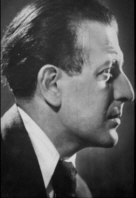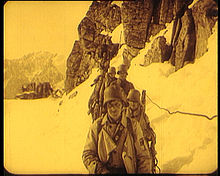Hero fight in snow and ice
| Movie | |
|---|---|
| Original title | Hero fight in snow and ice |
| Country of production | Austria-Hungary |
| original language | German |
| Publishing year | 1917 |
| length | 49 minutes |
Heroes' Fight in Snow and Ice is an Austro-Hungarian propaganda film by the k. and k. War press quarter from 1917, which was produced for the newsreel . At that time, films were a very new form of propaganda that was being used effectively for the first time. However, many of these productions have not survived. The film itself consists only of exterior shots, as it deals with the battles on the Alpine front in the Kronland Tyrol . Like all propaganda media, it was strictly censored . As was typical at the time, it is a silent film with text overlay, which, however, is shown, which is unusual, without any genre-specific musical accompaniment. The originator of “Heroes' Fight in Snow and Ice” remained unknown, but speculations suggest that it could be the work of the cameraman and later director Gustav Ucicky .
background
During the First World War, the Alpine front was a line between Austria-Hungary and the Kingdom of Italy of little strategic importance . However, battles at 2,000 to 3,000 meters above sea level could ideally be sold to the population as heroism and the mountain fighters stylized as heroes, as can be read here from the film title. In fact, no real war of movement took place at these heights because there was simply no space for it. In the beginning, some mountain peaks were occupied by soldiers with mountain experience in patrols , but these did not offer more than small advantages for their own troops. Therefore a "war of the mountain guides" began, in which every little elevation was fought. So it is not surprising that in the war winter of 1916/17 more mountain soldiers were killed by avalanches than by enemy bullets. The aim of these battles was to attack the enemy from higher positions and destroy their high alpine positions.
Twelve Isonzo battles took place on the southeast front between Austria-Hungary and Italy until the end of the war. In sections, the war in the Alps lasted until 1918. As in every propaganda film, the hero fight in snow and ice had to demonstrate one's own strength and superiority against the enemy. In general, success stories from the front dominated the military and cinematic propaganda, and the effectiveness of one's own weapons and warfare was emphasized.
action
The film is divided into two parts. The first part starts with a picture of a mountain idyll. This picture is reinforced by the occasional skier on the slope. In the background you can clearly see smoke rising, but without being able to recognize its cause. The first reference to the troops is provided by the first text overlay, which speaks of a soldier town in the ice. A short shot of the mountain village follows, followed by the next mountain shot. Usually the text overlays provide information about what will be seen in the pictures below. Following the text, enemy movements and troops are shown. Soldiers fight their way through the deep snow, which shows how brave and tough your own soldiers are. The text underlines this with the statement "right through the walls".
Then the cameraman shows us soldiers doing their work. At this point, the faces of the filmed soldiers can also be recognized for the first time. Most of them are young men. After a short screen, which shows the entire patrol again, the next text follows. He announces that the group of soldiers is starting to climb a 3500 meter high firn in order to have a better view of the enemy positions. The footage shows the men’s difficult ascent through waist-deep snow. Climbing the summit is also ideal for showing the camaraderie between the men, for example how they support each other on the hard climb up the rock face and even pull them along if necessary. At the end of this scene, the patrol has conquered the firn and is now looking into the distance from the summit.
In keeping with this, the film fades to the fourth shot of the mountains, so that the viewer just doesn't forget where we are. For the first time in the text there is talk of enemy attacks. A cable car ride from the cameraman's point of view gives the viewer the impression of being in the Alps themselves, and it strengthens the sense of togetherness in the observer. A text is shown that speaks of the releasing of exhausted troops. This is followed by frequently changing shots that show the march or the rise of the fresh troops, which is intended to bring the viewer closer to the movement in the mountains. In addition, short texts are repeatedly faded in, which again point out that the soldiers have to master both the difficult ascent and descent on foot. So far only very small groups have been shown, mostly with about five men. Now whole crowds are moving through the rock faces. It can also be seen that the fresh soldiers are deliberately marching past the camera, with some laughing straight into the camera. The pictures also repeatedly show the inexhaustible camaraderie among the men, both with the relieved and newly deployed troops. In the last shot shown, the men no longer seem young and dynamic, they are tired and marked by the fight.
The text then indicates that it will now be possible to see how heavy artillery is being prepared. The heavy mountain cannon is transported over steep glaciers. The following text brings drama into the event, as it can be read that the enemy should be seen. However, nothing of an enemy can be seen in the images that appear afterwards. Images of the cable car can be seen again, but this time with a material delivery that the troops received on this way. The text explains to the viewer that before the attack on the enemy, the terrain must be cleared up by trained mountain guide patrols. The last text overlay in the first part is a message to the people: The Austro-Hungarian troops are on heights that humans have not yet been able to colonize. The last image in the first part, which ends after 27 minutes, is the sixth mountain image.
You can see a clear difference between the first and second part in the first scene. The next text display reads: "Attack on the enemy base at 3274". The first picture therefore shows soldiers in a trench . Text and picture are then compliant, both show how the commander swears his troops to the attack and gives final instructions. After 28:55 minutes, a first recognizable shot is fired. The trench in which the commander is standing is being shot at by the enemy. On the morning of the attack, the storm troop in reserve is alerted according to the text. The pictures also show soldiers ready to fight. In addition, the enemy base is captured from a distance for the first time in this scene.
During the recordings it is explained that a rapid fire gun is being pulled into an improvised fireplace. This is followed by another text “The storm troop on the march”. The pictures show the storm troop as they are deployed. Text and image alternate very quickly and frequently in this phase of the film. Another picture of the storm troop is shown as it is advancing against the enemy. In minute 34, the cannon prepared beforehand is used to fire the first own shot. The artillery then quickly fades back to the advancing storm troop in order to build up the drama and hectic. This cutting together of the individual images and texts gives the film a completely different character than in the first part. The wording of the texts is also becoming shorter and more concise. The own artillery hits in the enemy positions are shown very clearly. Counterattacks or counterfire, however, cannot be recognized.
Now the storm troop is finally advancing against the enemy. The soldiers storm the enemy position uphill, supported by text overlay. This scene of one's own attack is drawn into a never-ending length. The rapid changes between artillery, text and storm troop follow again and again. Then the first dead can be recognized, which can be assigned to the storm troop. During the entire course of the fight there was only a very short resistance, which can only be seen on the recordings based on the dead. The text proclaims “The height has been taken”, so our own troops were victorious. This is followed by a text overlay explaining that the dead and injured are now being transported away and the base is being expanded. Unsuccessful enemies are stabbed to death by members of the storm troop. It shows how injured people are brought out of the line of fire. Enemy prisoners are evacuated.
The soldiers' thirst for action can be seen in the last text. An enemy base has only just been stormed, and you can already look into the distance at the firne and the peaks, where the main enemy positions are. Like the beginning of the film, the last shot is a mountain shot. Then the film ends.
criticism
The transition between fiction and documentary film was fluid at the time. So it was common to take a lot of pictures and cut them in quick succession. In 1917 the film undermined the rules of the war press headquarters. It obviously shows the exhausted, unmotivated faces of the fighters, the endless expanses of the mountains and insurmountable masses of snow. It does not contribute to strengthening the self-confidence of the nation like an ordinary propaganda film, but shows that one's own strength has reached the end.
Others
- The alpine front often served as a propaganda motif
- Italian counterpart: War in the Alps (1917)
- The number of fictional propaganda films increased with the duration of the war
- The production company "Sascha Film" belonged to the most important Austrian filmmaker of the time: Count Alexander Sascha Kolowrat
Web links
- Freely accessible version of the film in the Filmarchiv Austria
Individual evidence
- ↑ Heroes' battle in ice and snow Source: The German Early Cinema Database
- ↑ A hero fight in snow and ice, Filmstill, A 1917. Retrieved on August 25, 2015 .
- ↑ A hero fight in snow and ice. Retrieved August 25, 2015 .
- ↑ a b c The heroes in front of the camera. Retrieved August 25, 2015 .
- ↑ Heroes' Fight in Snow and Ice (1918). Retrieved August 25, 2015 .
- ↑ A hero fight in snow and ice. Recordings of the film site of the Austro-Hungarian war press quarter. (No longer available online.) Archived from the original on September 24, 2015 ; Retrieved August 25, 2015 . Info: The archive link was inserted automatically and has not yet been checked. Please check the original and archive link according to the instructions and then remove this notice.
- ↑ a b c 1914: Film discovered as a propaganda tool. Retrieved August 25, 2015 .


